Lower Extremity Bracing
Foot Orthotics
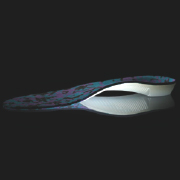 Foot orthotics are a very common orthosis used when the patient experiences foot pain when standing and walking. Foot orthotics can be prescribed to address a variety of conditions and the orthotic is fit to alleviate the prescribed specific symptoms. A foot orthotic can come in both custom molded or custom fit varieties, or as an off-the-shelf product.
Foot orthotics are a very common orthosis used when the patient experiences foot pain when standing and walking. Foot orthotics can be prescribed to address a variety of conditions and the orthotic is fit to alleviate the prescribed specific symptoms. A foot orthotic can come in both custom molded or custom fit varieties, or as an off-the-shelf product.
Ankle Support / Guantlet
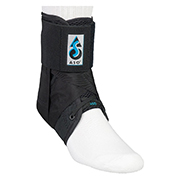 Another common and basic orthosis, ankle supports or Guanlets are prescribed to address simple ankle pain caused by an ankle sprain or other minor injury. The brace provides mild support to allow the foot and ankle to heal. The brace is usually discontinued once the injury is healed.
Another common and basic orthosis, ankle supports or Guanlets are prescribed to address simple ankle pain caused by an ankle sprain or other minor injury. The brace provides mild support to allow the foot and ankle to heal. The brace is usually discontinued once the injury is healed.
SMOs (Supra-malleolar Orthosis)
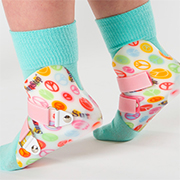 The SMO is used for flexible foot deformities that require good control of the heel. This brace is most commonly used for pediatric patients when a foot is heavily pronated (the foot rolls inwards and the arch of the foot flattens).
The SMO is used for flexible foot deformities that require good control of the heel. This brace is most commonly used for pediatric patients when a foot is heavily pronated (the foot rolls inwards and the arch of the foot flattens).
Wheaton Brace
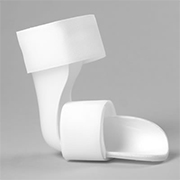 The Wheaton Brace is used to treat metatarsus-adductus (a common foot deformity noted at birth that causes the front half of the foot, or forefoot, to turn inward) and is sometimes used after serial casting to correct clubfoot. This is a prefabricated brace that is sized from patient measurements.
The Wheaton Brace is used to treat metatarsus-adductus (a common foot deformity noted at birth that causes the front half of the foot, or forefoot, to turn inward) and is sometimes used after serial casting to correct clubfoot. This is a prefabricated brace that is sized from patient measurements.
AFOs (Ankle Foot Orthosis)
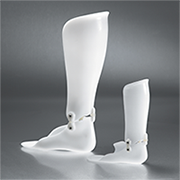 An AFO is used to stabilize the foot and ankle due to weakness or other deficiency. This orthosis can be custom made from molded plastic and other materials.
An AFO is used to stabilize the foot and ankle due to weakness or other deficiency. This orthosis can be custom made from molded plastic and other materials.
Carbon AFOs
Carbon AFOs are made from a carbon composite designed to provide either rigid or energy-returning properties. This brace can come in custom or custom fit versions depending on the needs of the patient. Due to the qualities of this material, the brace can come in a very rigid or flexible energy-returning variety.
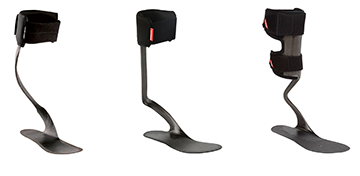
Metal and Leather AFO
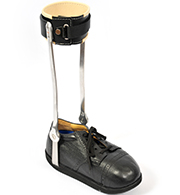 This type of AFO is most commonly used in instances where minimal contact between the patient and brace is desired. It is custom made from measurements and a tracing of the affected limb. The metal Orthosis is then bent to these parameters. The metal and leather AFO can also be desired as a very heavy duty alternative for patients tending to be very hard on their AFO brace and require the strength of aluminum or steel.
This type of AFO is most commonly used in instances where minimal contact between the patient and brace is desired. It is custom made from measurements and a tracing of the affected limb. The metal Orthosis is then bent to these parameters. The metal and leather AFO can also be desired as a very heavy duty alternative for patients tending to be very hard on their AFO brace and require the strength of aluminum or steel.
Hip Abduction Orthosis
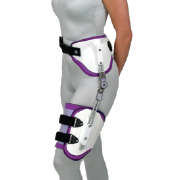 A hip abduction orthosis may be used for a number of hip joint conditions including dislocation, fracture, or post surgical. This type of brace can limit flexion and extension of the joint as well as abduction and adduction.
A hip abduction orthosis may be used for a number of hip joint conditions including dislocation, fracture, or post surgical. This type of brace can limit flexion and extension of the joint as well as abduction and adduction.
Stance Control Orthosis
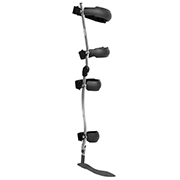 This orthosis is used in instances where a patient still has some control of the lower limb, but their condition has caused weakness in the muscles that maintain the knee in stance. The knee joint of this brace can have electronic or mechanical control that automatically lock and unlock the knee joint while walking to allow for more natural walking motion.
This orthosis is used in instances where a patient still has some control of the lower limb, but their condition has caused weakness in the muscles that maintain the knee in stance. The knee joint of this brace can have electronic or mechanical control that automatically lock and unlock the knee joint while walking to allow for more natural walking motion.
RGO (Reciprocating Gait Orthosis)
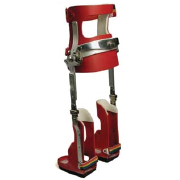 The RGO is used to allow individuals with paralysis to walk without completely locking up the hip joints. Use of this orthosis can help prevent hip contractures due to constant sitting.
The RGO is used to allow individuals with paralysis to walk without completely locking up the hip joints. Use of this orthosis can help prevent hip contractures due to constant sitting.
Functional Knee Orthosis
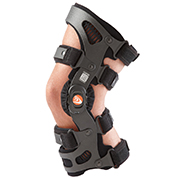 The functional knee orthosis is a very common type of knee brace and is usually prescribed in instances of knee ligament damage (ACL, PCL, etc.) or the need to offload a knee compartment due to osteoarthritis.
The functional knee orthosis is a very common type of knee brace and is usually prescribed in instances of knee ligament damage (ACL, PCL, etc.) or the need to offload a knee compartment due to osteoarthritis.
WalkAide System
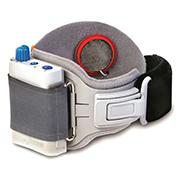 The WalkAide system is an electrical stimulation system used in instances when a patient suffers from drop foot, but still has an intact nerve pathway from the affected limb to the spine. The WalkAide is set up to provide a mild electrical stim when the patient is walking that tell the body when to fire the muscles that lift the foot.
The WalkAide system is an electrical stimulation system used in instances when a patient suffers from drop foot, but still has an intact nerve pathway from the affected limb to the spine. The WalkAide is set up to provide a mild electrical stim when the patient is walking that tell the body when to fire the muscles that lift the foot.
